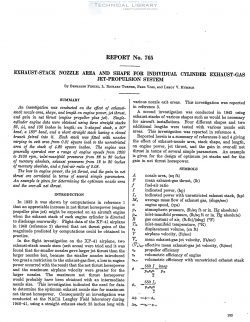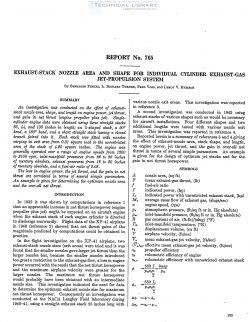naca-report-765

- Version
- 197 Downloads
- 1.76 MB File Size
- 1 File Count
- August 30, 2016 Create Date
- August 30, 2016 Last Updated
National Advisory Committee for Aeronautics, Report - Exhaust Stack Nozzle Area and Shape for Individual Cylinder Exhaust Gas Jet Propulsion System

An investigation was conducted on the efi'ect of exhaust-
staclc nozzle area, shape, and length on engine power, jet thrust,
and gain in net thrust (engine propeller plus jet). Single-
cylinder engine data were obtained using three straight stacks
335, 44, and 108 inches in length; an S-shaped stack, a 90°
bend, a 180° bend, and a short straight stack having a closed
branch faired into it. Each stack was fitted with nozzles
varying in exit area from 0.91 s'quare inch to the unrestricted
area of the stack of 4.20 square inches. The engine was
generally operated over a range of engine speeds from 1300
to 2100 rpm, inlet-manifold pressures from 22 to 36’ inches
of mercury absolute, exhaust pressures from 12 to 30 inches
of mercury absolute, and a fuel-air ratio of 0.08.
The loss in engine power, the jet thrust, and the gain in net
thrust are correlated in terms of several simple parameters.
An emmple is given for determining the optimum nozzle area
and the over—all net thrust.
In 1932 it was shown by computations in reference 1
that an appreciable increase in net thrust horsepower (engine
propeller plus jet) might be expected on an aircraft engine
when the exhaust stack of each engine cylinder is directed
to discharge rearwardly. Flight data of the XP—41 airplane
in 1940 (reference 2) showed that net thrust gains of the
magnitude predicted by computations could be obtained in
practice.
In the flight investigation on the KID—41 airplane, two
exhaust-stack nozzle sizes (exit areas) were tried and it was
found that the smaller nozzles gave larger jet thrust than the
larger nozzles but, because the smaller nozzles introduced
too great a restriction to the exhaust-gas flow, a loss in engine
power occurred with the result that the net thrust horsepower
and the maximum airplane velocity were greater for the
larger nozzles. The maximum net thrust horsepower
would probably have been obtained with an intermediate
nozzle size. This investigation indicated the need for data
to determine the optimum exhaust nozzle size for maximum
net thrust horsepower. Consequently an investigation was
conducted at the NACA Langley Field laboratory during
1940—41, using a straight exhaust stack 25 inches long with
various nozzle exit areas. This investigation was reported
in reference 3.
| File | Action |
|---|---|
| naca-report-765 Exhaust Stack Nozzle Area and Shape for Individual Cylinder Exhaust Gas Jet Propulsion System.pdf | Download |

Comment On This Post